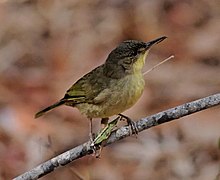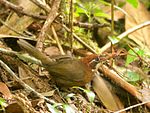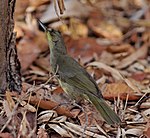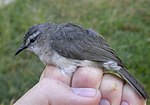| Madagascan warblers | |
|---|---|

| |
| The long-billed bernieria (Bernieria madagascariensis) was formerly placed in the Pycnonotidae | |
| Scientific classification | |
| Domain: | Eukaryota |
| Kingdom: | Animalia |
| Phylum: | Chordata |
| Class: | Aves |
| Order: | Passeriformes |
| Superfamily: | Sylvioidea |
| Family: | Bernieridae Cibois, David, Gregory & Pasquet, 2010 |
| Genera | |
|
see text | |
The tetrakas, also known as the Malagasy warblers, are a recently validated family of songbirds. They were formally named Bernieridae in 2010. The family currently consists of eleven species (in eight genera) of small forest birds. These birds are all endemic to Madagascar.
In 1934, the monophyly of this group was proposed by Finn Salomonsen but the traditional assignments of these birds were maintained, mistaken by their convergent evolution and the lack of dedicated research. The families to which the Malagasy warblers were formerly assigned—Pycnonotidae (bulbuls) and even more so Timaliidae (Old World babblers) and the Old World warbler—were used as "wastebin taxa", uniting unrelated lineages that were somewhat similar ecologically and morphologically.
It was not until the analysis of mtDNA cytochrome b and 16S rRNA as well as nDNA RAG-1 and RAG-2 exon sequence data, that the long-proposed grouping was accepted.
Taxonomy and systematics
The family contains 11 species divided into 8 genera.
| Image | Genus | Species |
|---|---|---|
 |
Oxylabes Sharpe, 1870 |
|
 |
Bernieria Pucheran, 1855 |
|
| Cryptosylvicola Goodman, Langrand & Whitney, 1996 |
| |
 |
Hartertula Stresemann, 1925 |
|
 |
Thamnornis Milne-Edwards & Grandidier, 1882 |
|
 |
Xanthomixis Sharpe, 1881 |
|
| Crossleyia Hartlaub, 1877 |
| |
 |
Randia Delacour & Berlioz, 1931 |
|
The first phylogeny of the Bernieridae to include all eleven recognized species was performed by Younger et al. 2019:
| Bernieridae |
| ||||||||||||||||||||||||||||||||||||||||||||||||||||||||||||||||||||||||
Notably, this phylogeny suggests that the genus Xanthomixis is paraphyletic, with X. tenebrosa more closely related to Crossleyia xanthophrys than to the other members of Xanthomixis. Additionally, Bernieria madagascariensis appears to be composed of three deeply diverging lineages, which may each deserve species status. However, official taxonomic descriptions of these discoveries are yet to be published.
Several Bernierids are very poorly known and were described by science only very recently. Appert's tetraka was only described in 1972 and the cryptic warbler in 1996. The Appert's tetraka, along with the dusky tetraka are threatened by habitat loss, and are listed as vulnerable.
Most members of this family live in the humid rainforests in the east of Madagascar, though a few species are found in the drier southwest of the island. They feed on insects and will form mixed-species feeding flocks of up to six species while foraging. Additionally, Bernierid species are the only known hosts for the feather mite genus Bernierinyssus.
References
- Cibois, Alice; David, Normand; Gregory, Steven M. S.; Pasquet, Eric (2010). "Bernieridae (Aves: Passeriformes): a family-group name for the Malagasy sylvioid radiation" (PDF). Zootaxa. 2554: 65–68. doi:10.11646/zootaxa.2554.1.6. Archived (PDF) from the original on 30 June 2021. Retrieved 25 October 2010.
- Cibois, Alice; Pasquet, Eric; Schulenberg, Thomas S. (1999). "Molecular systematics of the Malagasy babblers (Passeriformes: Timaliidae) and warblers (Passeriformes: Sylviidae), based on cytochrome b and 16S rRNA sequences". Molecular Phylogenetics and Evolution. 13 (3): 581–595. Bibcode:1999MolPE..13..581C. doi:10.1006/mpev.1999.0684. PMID 10620415.
- Cibois, Alice; Slikas, Beth; Shulenberg, Thomas S.; Pasquet, Eric (2001). "An endemic radiation of Malagasy songbirds is revealed by mitochondrial DNA sequence data". Evolution. 55 (6): 1198–1206. doi:10.1554/0014-3820(2001)055[1198:AEROMS]2.0.CO;2. PMID 11475055. PDF fulltext
- Beresford, P.; Barker, F.K.; Ryan, P.G.; Crowe, T.M. (2005). "African endemics span the tree of songbirds (Passeri): molecular systematics of several evolutionary 'enigmas'". Proceedings of the Royal Society B. 272 (1565): 849–858. doi:10.1098/rspb.2004.2997. PMC 1599865. PMID 15888418.
- ^ Gill, Frank; Donsker, David, eds. (2018). "Grassbirds, Donacobius, Malagasy warblers, cisticolas, allies". World Bird List Version 8.1. International Ornithologists' Union. Archived from the original on 4 October 2018. Retrieved 27 January 2018.
- ^ Younger, Jane L.; Block, Nicholas L.; Raherilalao, Marie J.; Maddox, J. Dylan; Wacker, Kristen S.; Kyriazis, Christopher C.; Goodman, Steven M.; Reddy, Sushma (31 October 2019), Diversification of a cryptic radiation, a closer look at Madagascar's recently recognized bird family, doi:10.1101/825687, retrieved 16 July 2024
- Mironov, S. V.; Klimov, P. B.; Block, N. L.; Oconnor, B. M (2 October 2020). "Feather mites of the new genus Bernierinyssus gen. n. (Acariformes: Pteronyssidae) from endemic Malagasy warblers (Passeriformes: Bernieridae)—a lineage showing symbiotic cospeciation with their avian hosts". Systematic and Applied Acarology. 25 (10): 1765–1802. doi:10.11158/saa.25.10.5. ISSN 1362-1971.
Further reading
- Del Hoyo, J.; Elliot, A. & Christie D. (editors). (2006). Handbook of the Birds of the World. Volume 11: Old World Flycatchers to Old World Warblers. Lynx Edicions. ISBN 84-96553-06-X.
- Roberson, Don (2006): The break-up of the Old World warblers: A discussion of the 'new' tree Archived 20 February 2009 at the Wayback Machine. Version of 2006-06-26. Retrieved on 2007-05-12.
- Salomonsen, F. (1934): Revision of the Madagascar Timaliine birds. Ann. Mag. Nat. Hist. (10th series) 14: 60–79.
| Taxon identifiers | |
|---|---|
| Bernieridae | |